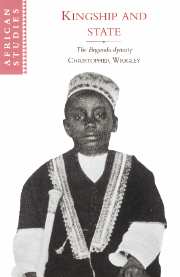Book contents
- Frontmatter
- Contents
- List of illustrations
- Preface
- Notes on language
- List of abbreviations
- 1 Preamble
- 2 The story and its making
- 3 Introduction to myth
- 4 Introduction to Buganda
- 5 The remoter past
- 6 Genesis
- 7 The cycle of the kings
- 8 Fragments of history
- 9 Foreign affairs
- 10 The making of the state
- 11 Reflections
- Notes
- Bibliography
- Index
- Other books in the series
7 - The cycle of the kings
Published online by Cambridge University Press: 12 January 2010
- Frontmatter
- Contents
- List of illustrations
- Preface
- Notes on language
- List of abbreviations
- 1 Preamble
- 2 The story and its making
- 3 Introduction to myth
- 4 Introduction to Buganda
- 5 The remoter past
- 6 Genesis
- 7 The cycle of the kings
- 8 Fragments of history
- 9 Foreign affairs
- 10 The making of the state
- 11 Reflections
- Notes
- Bibliography
- Index
- Other books in the series
Summary
The child and the dancers
Like his father, Kintu, the second king, Cwa Nabakka, is said to have disappeared from the land, and the dynastic history starts again with the coming of his grandson, Kimera. The claim that the newcomer, though born in Bunyoro, had been begotten there by Cwa's son Kalemeera has been dismissed by critical historians as an attempt to mask the arrival of a new dynasty of Nyoro origin. Some have, in addition, detected a second break in continuity after the reign of King Nakibinge, who is assigned to the sixth generation after Kimera and the twelfth before the colonial era. In his days the kingdom was invaded by a Nyoro army, brought in by a rival prince; and at the last he was left to face them alone, supported only by his heroic wife Nannono, who sharpened reeds for him to throw when he had run out of spears. After his death she acted as regent for a time, and if the child she was carrying had been male he would have been given the kingship; but when she gave birth to a girl the kingmakers turned elsewhere. When the campaign started, Nakibinge had sent his other wives and their children to a hiding-place on the eastern border; and although the oldest of his sons, Mulondo, was only a small child he was now brought back and installed as king. It seems strange that the Nyoro should have permitted a peaceful succession, especially of a child, and the borderland refuge story looks suspiciously like another cover for a foreign usurper.
- Type
- Chapter
- Information
- Kingship and StateThe Buganda Dynasty, pp. 122 - 168Publisher: Cambridge University PressPrint publication year: 1996

